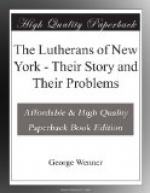A few years later, in 1888, the younger men caught the inspiration and established The Luther League. The organization soon extended to other parts of the State and subsequently to the entire country. It has splendidly attained its objective, that of rallying and training the young people in the support and service of the church. Its official organ, The Luther League Review, is published in this city under the editorship of the Hon. Edward F. Eilert. Eleven hundred members are enrolled in the local Leagues of New York City.
The first practical attempt of the ministers to get together was in the organization of “Koinonia.” This took place in the home of the writer in 1896. The society meets once a month for the purpose of discussing the papers which each member in his turn is required to read. Representing as it does Lutherans of all kinds, species and varieties, it serves as a clearing house for the theological output of the members. It has been helpful in removing some of the misunderstandings that are liable to arise among men of positive convictions.
On the third Sunday in Advent, 1898, Sister Emma Steen, of Richmond, Indiana, the first Lutheran deaconess to engage in parish work in New York, was installed in Christ Church. She had received her preparation for this ministry in the motherhouse at Kaiserswerth on the Rhine, and was one of the first six sisters to enter the motherhouse of the General Synod in Baltimore. After four years of faithful service she was succeeded by Sister Regena Bowe who has now for fifteen years by her devoted work illustrated the value of the female diaconate in the work of our churches in New York. Deaconeses are now laboring in seven of our churches. They are needed in a hundred congregations.
The revival of this office is due to the genius and
zeal of Pastor Fliedner who established the first
motherhouse at Kaiserswerth on the Rhine in 1833.
In America there are eight motherhouses with an enrollment
of 378 sisters.*
In 1885 the author
was appointed chairman of a committee of the
General Synod to report on the practicability of establishing
the office of deaconess in the parish work of our
American churches. In pursuit of information
he visited the principal Deaconess Houses of Europe.
His reports were published in the Minutes of the Synod
from 1887 to 1897 and contributed to the introduction
of the office into the Synod’s scheme of church
work.
The years under review, the closing period of the nineteenth century, were years of stress and storm in our synodical relations. But the questions that divided us did not stop the practical work of the synods. Under the stimulus of a generous rivalry some things were accomplished and foundations were laid for still larger work in the new century.
In the Twentieth Century 1900-1918
Our churches entered the twentieth century with hope and cheer. With an enrollment of 94 congregations in the greater city and an advance patrol of many more in the Metropolitan District, it had become an army of respectable size among the forces striving for the Christian uplift of our city.




